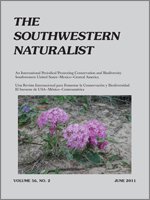During 2003–2005, I surveyed 82 sites on the North and South rims of Grand Canyon, Coconino County, Arizona, to test effectiveness of four non-invasive techniques for detecting carnivores and to assess patterns of co-occurrence among pairs of species. Techniques were not equally effective for detecting carnivores. Searches of transects for feces, tracks, and other evidence yielded the greatest number of detections; remotely triggered cameras and track plates had the greatest probabilities of detecting common species and also produced detections of smaller and rarer carnivores; and hair traps generally were ineffective. Even after accounting for variation in probabilities of use of habitats by species due to characteristics of sites, two pairs of carnivores had limited co-occurrence. Coyotes (Canis latrans) and bobcats (Lynx rufus) did not co-occur at sites on the North Rim, and coyotes and gray foxes (Urocyon cinereoargenteus) co-occurred less than one-half as frequently as expected in the South Rim.
How to translate text using browser tools
1 June 2011
Non-Invasive Methods to Assess Co-Occurrence of Mammalian Carnivores
Sarah E. Reed
ACCESS THE FULL ARTICLE

The Southwestern Naturalist
Vol. 56 • No. 2
June 2011
Vol. 56 • No. 2
June 2011




